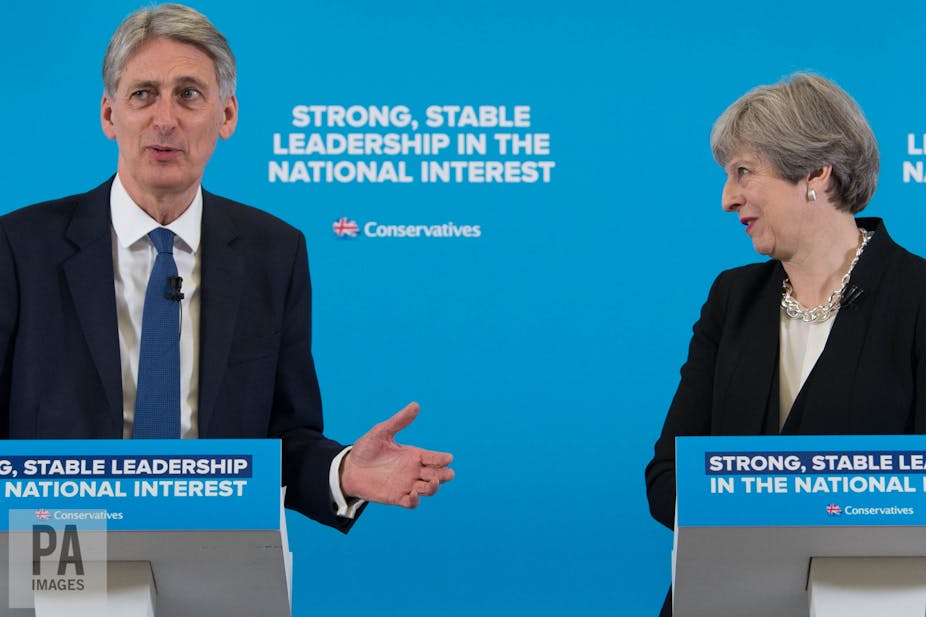When people come to look at this decision on June 8, they will have a choice between a Conservative party that has always been a low-tax party … and a Labour party that is about raising taxes, that is about higher taxes for the future.
Theresa May, Conservative prime minister, in an interview with the BBC’s Andrew Marr on April 30. May repeated the claim during her press conference to launch the Conservative party manifesto on May 18.
The history of tax and spending levels is more complicated than a politician’s slogan can capture. As the graph shows, Margaret Thatcher’s Conservative governments from 1979 undoubtedly slashed income tax rates.
Thatcher inherited from Labour a basic rate of income tax at 33%, and a higher marginal rate which could reach as high as 98%. By 1988, she had cut that higher rate dramatically to 40% and the basic rate to 25%. But this tax cut was partly offset when her government raised the indirect tax, VAT, from 8% to 15%. This is a less egalitarian way of taxing, because, unlike income tax, everyone pays at the same rate.
May says Labour is “about raising taxes”, but, as the graph shows, the 1997 New Labour government in fact maintained the lowered basic income tax rate, and indeed reduced it further. Economic boom times in the early 2000s enabled Tony Blair’s government to both raise public spending and keep taxation relatively low.
Labour’s historical appetite for endlessly higher tax and spending levels is somewhat exaggerated. There has always been a strong co-existing strain of fiscal prudence among progressives, dating back to the frugality of Victorian liberalism. The Labour chancellor, Denis Healey, was reining in public spending even at that high point of enthusiasm for the state in the late 1970s.
The Conservative desire to cut taxes is also complicated by the fact that it co-exists with its more paternalist, one nation instincts. Under Winston Churchill and Anthony Eden, the party certainly did keep tax levels lower in the 1950s, for instance, than Labour is likely to have done.
But the significant rise in tax and spending under Labour’s Harold Wilson in the 1960s had already begun under Conservative Harold Macmillan, who recalled vividly the stark inequality of the 1930s’ depression in his own Stockton-on-Tees constituency, and was determined never to return to it.
May herself has on several occasions drawn a distinction with her predecessor, David Cameron, in insisting that the state could be a “force for good”. If she wins the election, this tonal shift is likely to compete intriguingly with any aspiration to dramatically cut taxes, especially in relation to spending on the NHS.
Economic context is also everything. A recent report from the Institute of Fiscal Studies shows that due to the recession, government revenues actually fell under the supposedly more red-blooded Labour prime minister Gordon Brown, by 5.5% in 2009-10. Revenues then rose as a share of national income under the Conservatives, as they sought to fight off the deficit. Revenues are currently forecast to increase to roughly pre-2008 levels by 2020.
What the Conservatives can plausibly argue is that by their austerity policy since 2010 of significantly cutting public spending, from 45.2% to 40.1% of GDP, they kept taxation (or alternatively the deficit) from rising higher still.
It is also true that given Jeremy Corbyn’s plans outlined in the Labour manifesto to significantly raise both corporation tax and higher income tax rates for those earning above £80,000, the distinction between the parties on tax and spend is presently greater than is the recent historical norm.
Verdict
It is, in the end, broadly fair for Theresa May to say that the Conservative party, both historically, and in recent times, has been inclined to somewhat lower spending, and so levels of tax than Labour, and to a lesser extent the Liberal Democrats. But it is also fair to say the Conservatives tend to overplay the extent of this difference. The exclusive focus on tax is also a bit like looking at only one dimension in isolation of a three-dimensional, interconnected policy challenge. The other dimensions are the need for well-funded public services, which excessive tax cuts can undermine, and economic growth, without which tax receipts fall, and which is arguably left less certain in the context of Brexit.
Review
Katherine Cousins, doctoral researcher in taxation, University of Sheffield
I agree with the verdict. Historically, although periods of lower income tax have on the whole tended to coincide with periods of Conservative government, it is difficult to demonstrate that this is to a great enough extent, or indeed consistent enough, to conclusively point to the Conservative party as a low-tax party.
The author points to the accompanying rise in VAT across periods of lower income tax. We can see this pattern from the very beginning of the modern Conservative movement; upon the scrapping of the first income taxes in 1816, the Tory government instead turned to significant increases in expenditure taxes to address the high national outlay. Perhaps, then, a low tax policy is not, and has not been, universal across all branches of taxation.
Theresa May’s claim is by no means incorrect, or without substance. However, as the author has pointed out, it is unclear whether it is conclusive, or accounts for a complete picture of Conservative fiscal policy.
The Conversation is checking claims made by public figures and in the public domain. Statements are checked by an academic with expertise in the area. A second academic expert then reviews an anonymous copy of the article. Please get in touch if you spot a claim you would like us to check by emailing us at uk-factcheck@theconversation.com. Please include the statement you would like us to check, the date it was made, and a link if possible.

